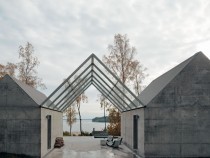
© Åke E:son Lindman
Colourful wood homes, scattered between water, boulders and trees, are an integral part of the idyllic image associated with Stockholm’s coastal landscape. On the island of Lagnö, between a forest and the Baltic Sea, a holiday domicile of a different sort has recently been completed. Like a row of boathouses, the five pitched roofs, each of a different height – its gables, unimpeded by eaves – form a striking silhouette against the natural background. Transversely spanning the elongated, orthogonal building massing, the roofs order the volumes and, in this manner, pick up on the shape and scale of the traditional building types.
Seen from the north, the ensemble appears closed to its surroundings. The sculptural building massing is interrupted by a transparent element – one of the gable roofs is articulated as steel and glass construction – that creates a fascinating entrance situation with framed view of the ocean. From here one decides whether to enter the separate guest apartment, which also serves as atelier, or the main house. The private spaces are situated along the rear facade, only receiving light from the rooflights flush with the plane of the roof. Sliding partitions of hardwood open toward the generously scaled living room, which, in turn, is separated from the outdoors by sliding glass doors; the house opens up gradually to daylight and to the sea.
The architects selected concrete – which is not a component of the local building tradition – as predominant building material. In comparison to wood it offers a practical advantage: resistance to weathering. Correspondingly, and in keeping with the clients’ request, it holds maintenance work to a minimum. With its massivity and its colour tone, concrete sets up a connection to the granite formations, which date to the Pleistocene Epoch, and makes the building appear to grow right out of the rocky ground. In contrast to the walls, the roof is not constructed in concrete, but of an insulated steel structure that is supported by the cast-in-place concrete walls. The slate-coloured roofing furnishes a uniform grey tone that preserves the monolithic impression.
Seen from the north, the ensemble appears closed to its surroundings. The sculptural building massing is interrupted by a transparent element – one of the gable roofs is articulated as steel and glass construction – that creates a fascinating entrance situation with framed view of the ocean. From here one decides whether to enter the separate guest apartment, which also serves as atelier, or the main house. The private spaces are situated along the rear facade, only receiving light from the rooflights flush with the plane of the roof. Sliding partitions of hardwood open toward the generously scaled living room, which, in turn, is separated from the outdoors by sliding glass doors; the house opens up gradually to daylight and to the sea.
The architects selected concrete – which is not a component of the local building tradition – as predominant building material. In comparison to wood it offers a practical advantage: resistance to weathering. Correspondingly, and in keeping with the clients’ request, it holds maintenance work to a minimum. With its massivity and its colour tone, concrete sets up a connection to the granite formations, which date to the Pleistocene Epoch, and makes the building appear to grow right out of the rocky ground. In contrast to the walls, the roof is not constructed in concrete, but of an insulated steel structure that is supported by the cast-in-place concrete walls. The slate-coloured roofing furnishes a uniform grey tone that preserves the monolithic impression.




